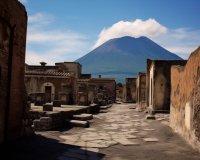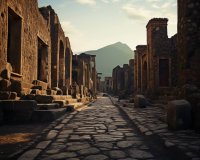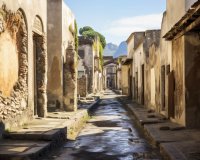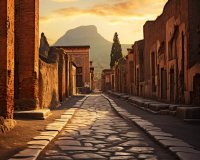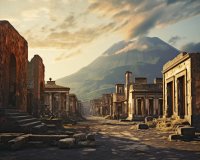Discover Pompeii and Vesuvius in a Day Trip
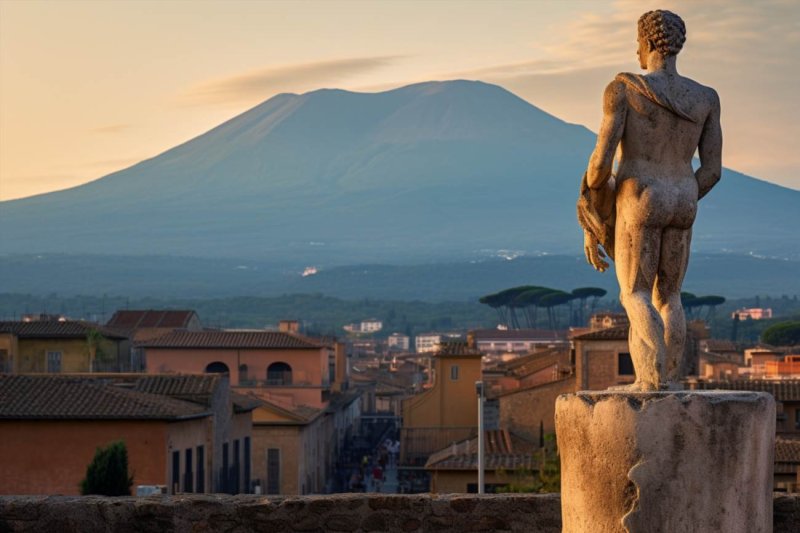
Discover Pompeii and Vesuvius in a Day Trip
If you're planning a trip to Italy, the ancient city of Pompeii and the towering Mount Vesuvius are two must-see destinations that can easily be explored in a day trip. This article will guide you through the wonders of Pompeii and the natural beauty of Vesuvius, offering tips and insights for an unforgettable experience.
Pompeii: Uncovering Ancient History
Pompeii, the Roman city frozen in time by the eruption of Mount Vesuvius in 79 AD, offers a unique glimpse into the past. As you explore the well-preserved streets and buildings, you'll find yourself immersed in the daily life of the ancient Romans.
Highlights of a Pompeii visit include the remarkably intact Roman Forum, the well-preserved Temple of Apollo, and the haunting plaster casts of the volcano's victims. Walking through the cobbled streets, you can almost hear the echoes of the past, making it a truly mesmerizing experience for history enthusiasts.
Visiting Pompeii: Practical Tips
Before you embark on your journey to Pompeii, here are some practical tips to make the most of your visit:
- Plan your visit early in the day to avoid crowds and the scorching midday sun.
- Wear comfortable walking shoes, as you'll be exploring the extensive site on foot.
- Consider hiring a local guide or using an audio guide to get in-depth insights into the history and significance of the site.
Mount Vesuvius: Conquering the Volcano
After your adventure in Pompeii, it's time to conquer Mount Vesuvius itself. This active volcano is a challenging yet rewarding climb, offering breathtaking panoramic views of the Bay of Naples and the surrounding landscape.
The hike to the summit of Mount Vesuvius takes you through winding trails and lush greenery. Once at the top, you'll peer into the steaming crater and gain a newfound respect for the powerful forces of nature. It's an awe-inspiring experience that allows you to connect with the Earth's geological history.
Preparing for Vesuvius:
Before you tackle the volcano, here's what you should know:
- Wear sturdy hiking boots and bring plenty of water and sunscreen.
- Check the weather conditions and ensure the trail is open for hiking on the day of your visit.
- While it's a relatively easy hike, be prepared for some steep and uneven terrain.
Combining Pompeii and Vesuvius:
Visiting both Pompeii and Vesuvius in one day is entirely feasible. Start your day early at Pompeii, exploring its fascinating ruins. Afterward, head to Mount Vesuvius for an afternoon adventure. Depending on your pace, you can easily cover both sites and make the most of your day trip.
It's a journey that offers a unique blend of history and nature, leaving you with memories and experiences that will last a lifetime. So, if you're looking for a day trip filled with cultural richness and natural beauty, discovering Pompeii and Vesuvius is the perfect choice!
Whether you're a history buff, a nature lover, or simply an adventurous traveler, this combination of ancient ruins and volcanic exploration will leave you with a deep appreciation for the wonders of Italy.
Transfer to Positano with Pompeii Guided Tour from Naples
Enjoy a one-way transfer from Naples to Positano with a stop for a guided tour in Pompeii. Optimize your time with this convenient transfer service that includes pickup from Naples and drop-off at Positano. Along the way, marvel at the stunning sights of the Sorrentine peninsula and the Bay of Naples. Stop at Pompeii for a two-hour guided tour, exploring significant landmarks such as the Marina Gate, Forum baths, and more.
Highlights:
- Transfer service from Naples to Positano
- 2-hour guided tour in Pompeii
- Witness key historical sites such as the Marina Gate and Forum baths
Relax in an air-conditioned private minivan during the journey and benefit from a skip-the-line admission ticket to make the most of your experience. This package includes transportation, guide services, and convenient pickup and drop-off, ensuring a seamless travel experience. Book your spot now and pay nothing today!
Price per person: From $372.43
Customer Reviews:
Overall rating: 4.9/5
Review summary:
- Value for money: 4.5/5
- Safety: 5/5
- Service: 5/5
- Organization: 4.8/5
Experience this remarkable journey, creating unforgettable memories of the rich history and breathtaking landscapes of Italy.
The History of Pompeii
Pompeii, the ancient Roman city buried by the catastrophic eruption of Mount Vesuvius in 79 AD, is a fascinating archaeological site that offers a unique glimpse into the past. The history of Pompeii is a tale of a thriving Roman city turned into an archaeological treasure trove.
Early Settlement: Pompeii's history dates back to the 8th century BC when it was founded by the Osci, an Italic people. Later, it was influenced by Greek colonization. It was a prosperous and strategically important city in the Roman Empire due to its location near the Bay of Naples.
Roman Influence: Pompeii was absorbed into the Roman Republic during the Samnite Wars in the 4th century BC. Under Roman rule, the city flourished, and its architecture and infrastructure were developed, including temples, theaters, and an amphitheater.
Life in Pompeii: Pompeii was a vibrant city with a population of around 20,000 people. It was known for its beautiful frescoes, intricate mosaics, and well-preserved buildings. The city was a center of commerce, art, and culture, and it had a bustling market, known as the Forum.
The Catastrophic Eruption: The most significant event in Pompeii's history occurred on August 24, 79 AD, when Mount Vesuvius erupted, burying the city under layers of ash and pumice. This catastrophic event preserved the city in remarkable detail, essentially freezing it in time.
Rediscovery: Pompeii remained lost for centuries until its accidental rediscovery in the 16th century. Excavations began in the 18th century, and they continue to this day. These excavations have unearthed a wealth of information about life in ancient Rome, from the architecture to the everyday items used by its inhabitants.
Archaeological Significance: Pompeii is an invaluable archaeological site. It provides insights into Roman urban planning, architecture, art, and daily life. The city's preservation is so thorough that it allows us to understand the layout of streets, the types of buildings, and even the social structure of the time.
Visiting Pompeii: Today, Pompeii is a UNESCO World Heritage Site and a popular tourist destination. Visitors can explore the remarkably preserved city streets, villas, public buildings, and the haunting plaster casts of victims, revealing the final moments of those caught in the eruption.
Preservation and Challenges: Despite its significance, Pompeii faces numerous preservation challenges. Weathering, deterioration, and damage from tourists are ongoing concerns. Efforts to balance conservation with accessibility are crucial to maintaining this historical gem for future generations.
Legacy: The history of Pompeii serves as a time capsule, shedding light on the daily lives of ancient Romans. Its tragic end has given us a unique opportunity to understand the past, and it remains a symbol of the power of nature and the resilience of archaeology.
In conclusion, the history of Pompeii is a story of a city that thrived in ancient times, met a tragic end, and was rediscovered to become one of the most significant archaeological sites in the world. Its legacy continues to captivate and educate people about the past.
Pompeii and Amalfi Coast: Unveiling Ancient Wonders
Embark on a mesmerizing full-day private tour that transcends the bustling city of Naples to explore the enchanting beauty of the Amalfi Coast and the historic ruins of Pompeii.
Discover the remnants of Pompeii, a once-thriving Roman town now preserved as an outdoor museum, frozen in time by the ashes of Mt. Vesuvius in 79 A.D. Stroll through its streets, witnessing ancient houses, shops, bars, and even a Roman brothel, offering a rare glimpse into life 2,000 years ago.
Marvel at the breathtaking coastal views as your English-speaking driver guides you along the southwestern coast of Italy. Pause for captivating photos overlooking Positano and its bay, capturing the essence of this picturesque region.
Continue your journey to the Amalfi Coast, renowned for its medieval fishing villages perched on hillsides overlooking the Mediterranean. Immerse yourself in the charm of this UNESCO World Heritage Site, taking in the clear blue waters and the iconic architecture of the villages.
Your experience includes roundtrip transportation from Naples, skip-the-line admission to Pompeii, and an archaeological guide fluent in English, Spanish, Italian, French, or German. Stay hydrated with complimentary bottled water and savor the convenience of a private group setting for a personalized exploration.
Indulge in the allure of Italy's rich history and stunning coastal landscapes on this exclusive full-day tour, where ancient wonders and natural beauty converge.
The Power and Majesty of Vesuvius and Its Impact on Pompeii
Vesuvius, one of the most famous and formidable volcanoes in the world, has long captured the imagination of people from all walks of life. Its power and majesty have been etched into history, particularly for its devastating eruption in 79 AD, which buried the ancient city of Pompeii in ash and preserved it for future generations to discover. This article explores the awe-inspiring characteristics of Vesuvius and the tragic fate of Pompeii.
The Unpredictable Fury of Vesuvius
Vesuvius, located on the Gulf of Naples in Italy, is renowned for its unpredictable and destructive nature. This stratovolcano can lay dormant for centuries, lulling the communities that surround it into a false sense of security. Yet, when it awakens, its fury knows no bounds. The 79 AD eruption was one such cataclysmic event that serves as a haunting reminder of nature's raw power.
The Eruption of 79 AD
The eruption of Vesuvius in 79 AD was, without a doubt, one of the most catastrophic volcanic events in history. The eruption spewed an enormous plume of ash, pumice, and volcanic gases high into the sky. This deadly cloud descended upon the city of Pompeii and its neighboring towns with unimaginable force, covering everything in its path.
The city's population, caught completely off guard, was engulfed in the falling ash and pumice. Those who didn't escape in time were entombed in the layers of volcanic debris. The city, with its streets, buildings, and people, was frozen in time, a snapshot of ancient Roman life forever preserved under the ash and pumice.
Preservation of Pompeii
Ironically, the very eruption that destroyed Pompeii also contributed to its preservation. The ash and pumice that blanketed the city acted as a protective layer, sealing and shielding the ancient structures and artifacts from the ravages of time and looters. This natural time capsule allowed archaeologists to uncover Pompeii's secrets centuries later.
Rediscovery and Ongoing Research
The rediscovery of Pompeii in the 18th century sparked immense interest in archaeology and the ancient world. Excavations have been ongoing for centuries, revealing a remarkable glimpse into the daily lives of ancient Romans. Streets, houses, shops, and even well-preserved frescoes offer a unique window into the past.
Archaeologists continue to study Pompeii, unearthing new findings and shedding light on various aspects of Roman life, from their social customs to their art and architecture. The site has become a treasure trove of historical information, enriching our understanding of the ancient world.
The Ongoing Threat of Vesuvius
Today, Vesuvius remains an active and potentially dangerous volcano. Millions of people live in the vicinity of the volcano, and the potential for future eruptions poses a significant risk. Authorities have established evacuation plans and monitoring systems to safeguard the lives of those in the danger zone.
In Conclusion
The power and majesty of Vesuvius are undeniable. Its eruption in 79 AD forever altered the course of history by preserving Pompeii, a city lost to time. The tragic events of that day continue to captivate and educate us, serving as a reminder of the unpredictable forces of nature.
As we marvel at the archaeological wonders of Pompeii, we must also remember the potential threat that Vesuvius still poses to the modern communities that call its shadow home. The lessons of the past, both awe-inspiring and cautionary, will forever be entwined with the power and majesty of Vesuvius and the fate of Pompeii.


